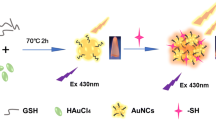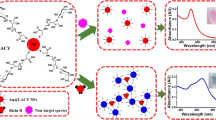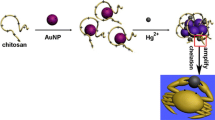Abstract
The amino thiols, methionine, cysteine, and homocysteine are considered to be important biomarkers for various diseases. In the present study, the authors have demonstrated that the interactions of synthesized citrate-capped gold nanoparticles with these amino thiols at different pH values can be used to develop simple colorimetric methods for their detection in aqueous solutions. The aggregation of the gold nanoparticles by interactions with the thiol group was found to depend strongly on the pH of the amino thiols. At pH 10, the detection of cysteine was possible in the presence of homocysteine at low concentration and similarly homocysteine could be detected in the presence of cysteine at low concentration by thiol-induced aggregation of the gold nanoparticles. Cysteine and methionine were specifically detected by monitoring the aggregation of the gold nanoparticles through the UV–Visible spectra at pH 7 and pH 10 respectively. The increase in the mean hydrodynamic diameter of the particles confirmed the thiol-induced aggregation of the particles both at pH 7 and pH 10. The specific pH-based interactions can form a basis to design simple colorimetric sensors for the amino thiols using as-synthesized citrate-capped gold nanoparticles without further functionalization.










Similar content being viewed by others
References
Toyo’oka T (2009) Recent advances in separation and detection methods for thiol compounds in biological samples. J Chromatogr B 877:3318–3330
Agüı L, Manso J, Yáñez-Sedeño P, Pingarrón JM (2004) Colloidal-gold cysteamine-modified carbon paste electrodes as suitable electrode materials for the electrochemical determination of sulphur-containing compounds: application to the determination of methionine. Talanta 64:1041–1047
Seshadri S, Beiser A, Selhub J, Jacques PF, Rosenberg IH, D’Agostino RB, Wolf PA (2002) Plasma homocysteine as a risk factor for dementia and Alzheimer’s disease. New Engl J Med 346:476–483
Hoshi T, Heinemann SH (2001) Regulation of cell function by methionine oxidation and reduction. J Physiol 531:1–11
Naughten ER, Yap S, Mayne PD (1998) Newborn screening for homocystinuria: irish and world experience. Eur J Pediatr 157:S84–S87
Carlucci F, Tabucchi A (2009) Capillary electrophoresis in the evaluation of aminothiols in body fluids. J Chromatogr B 877:3347–3357
Hellmuth C, Koletzko B, Peissner W (2011) Aqueous normal phase chromatography improves quantification and qualification of homocysteine, cysteine and methionine by liquid chromatography–tandem mass spectrometry. J Chromatogr B 879:83–89
Daniel MC, Astruc D (2004) Gold nanoparticles: assembly, supramolecular chemistry, quantum-size-related properties, and applications toward biology, catalysis, and nanotechnology. Chem Rev 104:293–346
Saha K, Agasti SS, Kim C, Li X, Rotello VM (2012) Gold nanoparticles in chemical and biological sensing. Chem Rev 112:2739–2779
Wei X, Qi L, Tan J, Liu R, Wang F (2010) A colorimetric sensor for determination of cysteine by carboxymethyl cellulose-functionalized gold nanoparticles. Anal Chim Acta 671:80–84
You J, Hu H, Zhou J, Zhang L, Zhang Y, Kondo T (2013) Novel cellulose polyampholyte–gold nanoparticle-based colorimetric competition assay for the detection of cysteine and mercury (II). Langmuir 29:5085–5092
Zhang YP, Chen J, Bai LY, Zhou XM, Wang LM (2010) Gold nanoparticle-based optical probe for quick colorimetric visualization of cysteine. J Chin Chem Soc 57:972–975
Shang L, Qin C, Wang T, Wang M, Wang L, Dong S (2007) Fluorescent conjugated polymer-stabilized gold nanoparticles for sensitive and selective detection of cysteine. J Phys Chem C 111:13414–13417
Chen Z, Luo S, Liu C, Cai Q (2009) Simple and sensitive colorimetric detection of cysteine based on ssDNA-stabilized gold nanoparticles. Anal Bioanal Chem 395:489–494
Lin JH, Chang CW, Tseng WL (2010) Fluorescent sensing of homocysteine in urine: using fluorosurfactant-capped gold nanoparticles and o-Phthaldialdehyde. Analyst 135:104–110
Xiao Q, Zhang L, Lu C (2012) Resonance light scattering technique for simultaneous determination of cysteine and homocysteine using fluorosurfactant-capped gold nanoparticles, Sens. Actuators B 166–167:650–657
Xiao Q, Shang F, Xu X, Li Q, Lu C, Lin JM (2011) Specific detection of cysteine and homocysteine in biological fluids by tuning the pH values of fluorosurfactant-stabilized gold colloidal solution. Biosens Bioelectron 30:211–215
Frens G (1973) Controlled nucleation for the regulation of the particle size in monodisperse gold suspensions. Nat Phys Sci 241:20–22
Obare SO, Hollowell RE, Murphy CJ (2002) Sensing strategy for lithium ion based on gold nanoparticles. Langmuir 18:10407–10410
Mocanu A, Cernica I, Tomoaia G, Bobos LD, Horovitz O, Cotisel ML (2009) Self-assembly characteristics of gold nanoparticles in the presence of cysteine. Colloids Surf A 338:93–101
Lewis DJ, Day TM, MacPherson JV, Pikramenou Z (2006) Luminescent nanobeads: attachment of surface reactive Eu(III) complexes to gold nanoparticles. Chem Commun 13:1433–1435
Pu W, Zhao H, Huang C, Wu L, Xu D (2013) Visual detection of arginine based on the unique guanidino group-induced aggregation of gold nanoparticles. Anal Chim Acta 764:78–83
Creighton TE (1993) Proteins: structures and molecular properties, 2nd edn. Freeman, New York
Hormozi-Nezhad MR, Seyedhosseini E, Robatjazi H (2012) Spectrophotometric determination of glutathione and cysteine based on aggregation of colloidal gold nanoparticles. Sci Iran 19:958–963
Lim S, Ip W, Crew E, Njoki PN, Mott D, Zhong CJ, Pan Y, Zhou S (2007) Homocysteine-mediated reactivity and assembly of gold nanoparticles. Langmuir 23:826–833
Jana NR, Gearheart L, Obare SO, Murphy CJ (2002) Anisotropic chemical reactivity of gold spheroids and nanorods. Langmuir 18:922–927
Pavia DL, Lampman GM, Kriz GS (2001) Introduction to spectroscopy. Harcourt College Publishers, Fort Worth
Aryal S, Remant BKC, Dharmaraj N, Bhattarai N, Kim CH, Kim HY (2006) Spectroscopic identification of SAu interaction in cysteine capped gold nanoparticles. Spectrochim Acta A 63:160–163
Kreibig U, Genzel L (1985) Optical absorption of small metallic particles. Surf Sci 156:678–700
Hunter RJ (1988) Zeta potential in colloid science: principles and applications. Academic Press, New York
Acknowledgments
The authors acknowledge Sophisticated Instrumentation Centre, Chemistry Division, SAS, VIT University for providing the FT-IR facility for carrying out the present study.
Conflict of interest
The authors declare that they have no conflict of interest.
Author information
Authors and Affiliations
Corresponding author
Electronic supplementary material
Below is the link to the electronic supplementary material.
Rights and permissions
About this article
Cite this article
Rajeshwari, A., Garg, K., Elavarasi, M. et al. Interaction of Citrate-Capped Gold Nanoparticles with the Selected Amino Thiols for Sensing Applications. Proc. Natl. Acad. Sci., India, Sect. B Biol. Sci. 87, 23–30 (2017). https://doi.org/10.1007/s40011-015-0567-0
Received:
Revised:
Accepted:
Published:
Issue Date:
DOI: https://doi.org/10.1007/s40011-015-0567-0




